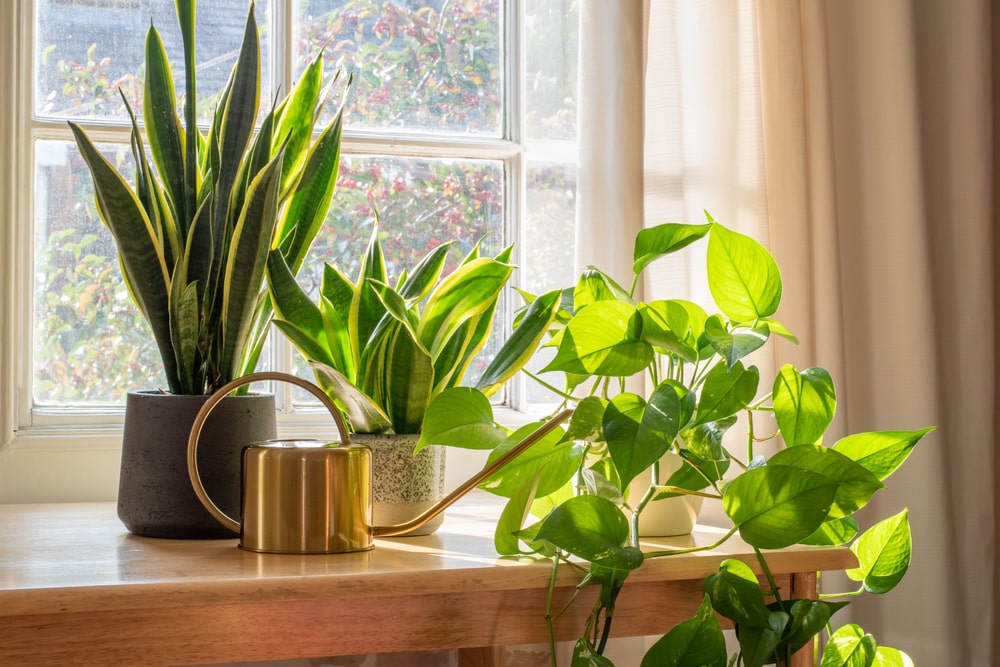It’s time to think about moving houseplants back inside for the winter.
One of the first things I do is move all the plants right up next to the house—just outside the window that they’ll be in when I move them inside. That gets them used to lower light while they still have Mother Nature to comfort them with fresh air and humidity. This will help them transition better to the less-than-ideal light inside.
Make Friends With Your Thermometer
Keep an eye on the thermometer from here on out. Philodendron, dracaenas, peace lilies, Phalaenopsis orchids do not like temps below 50 to 55 degrees so they’ll need to come soon. Most other plants tolerate night temperatures in the upper forties so they’ll stay out another week or so (just be sure to check the forecast every night). Holiday cactus, amaryllis, and ferns can all tolerate temperatures to around 40 degrees so they’ll stay out until they absolutely have to come in.
No Hitchhikers Allowed
Next step—examine plants for hitchhikers you don’t want inside. For annoyances like spiders or crickets, a quick sharp spray from the hose works. For more serious pests like mites, mealybugs, or aphids, a thorough cleaning followed by a spray of an organic pesticide will work. If you find scale, a horticultural oil spray is fine.
For pests in the soil, pull a gallon of water and let it stand overnight, then in the morning add four tablespoons of bleach and drench the soil. That will kill any unwanted soil pests—fungus gnat larvae, ants, slugs—hiding out in there. For small pots, you can also put several in a bucket filled with water. That’ll drown any soil-borne insects.
To Prune or Not to Prune? That is the Question!
The best advice is not to do any major pruning this time of year. If it’s a choice between you or the plant—or leaving the plant outside to freeze because you absolutely do not have the room—sometimes you do what you gotta do. Try to avoid major pruning, however, and just prune back what is absolutely necessary.
For Your Plants, It’s a Different World Inside
Remember that once inside, things change. Plants are in less light and the air is dry. This is a good time to go back to checking the soil with your finger before watering. Some plants may lose yellow leaves as they adjust to lower indoor light levels.
As long as they’re getting three or four hours of sun, the adjustment period shouldn’t last more than a week or two. If it lasts longer, that’s usually a clue they’re not getting enough sun so you may want to add a grow light. Remember, when you use a grow light, you need to plan to leave it on 16 hours a day, 7 days a week. Do not leave them on all the time as plants do need 8 hours of darkness.
With the exception of African violets and orchids, don’t feed most indoor plants from November through February. Also, try to avoid repotting houseplants until early spring.
Play “Misty” for Me
Some tender leaved plants have trouble with dry indoor air, so misting lightly can be beneficial—particularly for ferns, orchids, citrus, and most palms. Remember, misting is “fogging” the plant, not “raining” on it. Place your mister on a fine spray and spray the air around and over the plant. Do not spray so heavily ON the plant that it drips off—that’s “rain.”
Once everyone is tucked safely inside, enjoy the lush green foliage as you remind yourself that your indoor air will certainly be cleaner now.
Questions?
If you have questions about your specific plants and how they should be taken care of with the arrival of fall, stop by the Great Big Greenhouse and talk with one of our plant experts. We LOVE to talk plants and we’re here to help you with all your gardening needs.


Moving an asparagus fern indoors – when, removal of unwanted pests, etc. ??
Asparagus ferns should be moved indoors when night temps are forecast to drop below the mid-40’s. As far as unwanted pests, check to see if you have them. Asparagus ferns aren’t particularly prone to insect problems. If you do find pests in the soil, follow the directions in the blog for a soil drench. If you have pests on the plant, then a spray with Captain Jack’s Dead Bug Brew should address the problem. Remember, asparagus ferns are NOT ferns at all but are related to garden asparagus so need fairly bright light and to dry out fairly well between waterings.